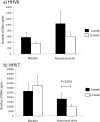Effects of nutritional supplementation on fatigue, and autonomic and immune dysfunction in patients with end-stage renal disease: a randomized, double-blind, placebo-controlled, multicenter trial
- PMID: 25746727
- PMCID: PMC4352065
- DOI: 10.1371/journal.pone.0119578
Effects of nutritional supplementation on fatigue, and autonomic and immune dysfunction in patients with end-stage renal disease: a randomized, double-blind, placebo-controlled, multicenter trial
Abstract
Background: Fatigue is a predictor of cardiovascular events in patients with end-stage renal disease (ESRD) undergoing hemodialysis treatment. We hypothesized that multinutritional support would improve quality of life, fatigue symptoms, and potential quantitative measures including endocrine, immune and autonomic functions in patients with ESRD undergoing hemodialysis.
Methods: Two hundred and two hemodialysis patients were randomly assigned to receive active treatment (containing vitamin B1, vitamin B2, niacin, vitamin B6, vitamin B12, folic acid, vitamin C, carnitine, coenzyme Q10, naïve galacto-oligosaccharide, and zinc) or placebo after each dialysis session for 12 weeks. The patients and attending physicians were blinded to the treatment, and 172 patients (86 in each group) completed the study. Fatigue was evaluated via fatigue questionnaire at 0, 4, and 12 weeks. To assess human herpes virus (HHV) 6 and 7 reactivation, numbers of viral DNA copies were determined in saliva by polymerase chain reaction at weeks 0 and 12. Autonomic function was determined via measurement of beat-to-beat variation by using acceleration plethysmography.
Results: Clinical characteristics, changes in fatigue, quality of life score, endocrine functions, and laboratory data did not differ significantly between the two groups. Several parameters of heart rate variability significantly increased after nutritional treatment compared to placebo. Nutritional drink for 12 weeks significantly suppressed HHV7 DNA copy numbers. Similarly, HHV6 DNA copy numbers tended to be decreased by treatment but without reaching statistical significance.
Conclusions: Nutritional supplementation may modulate immune and autonomic dysfunction in ESRD patients undergoing hemodialysis.
Conflict of interest statement
Figures



References
-
- Unruh M, Benz R, Greene T, Yan G, Beddhu S, Devita M, et al. Effects of hemodialysis dose and membrane flux on health-related quality of life in the HEMO Study. Kidney Int. 2004; 66: 355–366. - PubMed
-
- Kalantar-Zadeh K, Kopple JD, Block G, Humphreys MH. Association among SF36 quality of life measures and nutrition, hospitalization, and mortality in hemodialysis. J Am Soc Nephrol. 2001; 12: 2797–2806. - PubMed
-
- Elder SJ, Pisoni RL, Akizawa T, Fissell R, Andreucci VE, Fukuhara S, et al. Sleep quality predicts quality of life and mortality risk in haemodialysis patients: results from the Dialysis Outcomes and Practice Patterns Study (DOPPS). Nephrol Dial Transplant. 2008; 23: 998–1004. - PubMed
-
- Barron HV, Lesh MD. Autonomic nervous system and sudden cardiac death. J Am Coll Cardiol. 1996; 27: 1053–1060. - PubMed
Publication types
MeSH terms
Substances
LinkOut - more resources
Full Text Sources
Other Literature Sources
Medical

